- Home
- Dan Simmons
Worlds Enough & Time Page 20
Worlds Enough & Time Read online
Page 20
During the afternoon, with the sun blazing on the reflective bowl of ice that was the glacier, it got damned hot. The three of us humans damped our thermskin controls way down and shed our parka outer layers to cool off. The bug seemed comfortable enough, although he rested without complaint while we rested, drank water from his water bottle when we paused to drink, and chewed on something that looked like a shingle made of compressed dog poop while we munched our nutrient bars (which, I realize now, also looked a lot like a shingle made of compressed dog poop). If Kanakaredes suffered from overheating or chill that first long day on the glacier, he didn’t show it.
Long before sunset, the mountain shadow had moved across us and three of the four of us were raising our thermskin thresholds and tugging on the parka shells again. It had begun snowing. Suddenly a huge avalanche calved off the East Face of K2 and swept down the slope behind us, boiling and rolling over a part of the glacier we had been climbing just an hour earlier.
We all froze in our tracks until the rumbling stopped. Our tracks in the shadowed snow—rising in a more-or-less straight line for a thousand-foot elevation gain over the last mile or so—looked like they had been rubbed out by a giant eraser for a swath of several hundred yards.
“Holy shit,” I said.
Gary nodded, breathing a little hard since he had been breaking trail for most of the afternoon, turned, took a step, and disappeared.
For the last hours, whoever had been in the lead had probed ahead with his ice axe to make sure that the footing ahead was real and not just a skim of snow over a deep crevasse. Gary had taken two steps without doing this. And the crevasse got him.
One instant he was there, red parka glowing against the shadowed ice and the white snow on the ridge now so close ahead of us, and the next instant he was gone.
And then Paul disappeared as well.
No one screamed or reacted poorly. Kanakaredes instantly braced himself in full-belay posture, slammed his ice axe deep into the ice beneath him, and wrapped the line around it twice before the thirty feet or so of slack between him and Paul had played out. I did the same, digging crampons in as hard as I could, fully expecting the crevasse to pull the bug in and then me.
It didn’t.
The line snapped taut but did not snap—genetically tailored spidersilk climbing rope almost never breaks—Kanakaredes’s ice axe stayed firm, as did the bug holding it in the glacier ice, and the two of us held them. We waited a full minute in our rigid postures, making sure that we weren’t also standing on a thin crust over a crevasse, but when it was obvious where the crevasse rim was, I gasped, “Keep them tight,” unclipped, and crawled forward to peer down the black gap.
I have no idea how deep the crevasse was—a hundred feet? A thousand? But both Paul and Gary were dangling there—Paul a mere fifteen feet or so down, still in the light, looking fairly comfortable as he braced his back against the blue-green ice wall and rigged his climbing jumars. That clamp and cam device, infinitely lighter and stronger but otherwise no different than the jumars our grandfathers might have used, would get him back up on his own as long as the rope held and as soon as he could get the footloops attached.
Gary did not look so comfortable. Almost forty feet down, hanging headfirst under an icy overhang so that only his crampons and butt caught the light, he looked as if he might be in trouble. If he had hit his head on the ice on the way down…
Then I heard him cursing—the incredible epithets and shouts almost muffled in the crevasse, but still echoing deep as he cursed straight into the underbelly of the glacier—and I knew that he was all right.
It took only a minute or so for Paul to jumar up and over the lip, but getting Gary rightside up and then lifted up over the overhang so he could attach his own jumars, took a bit longer and involved some manhauling.
That’s when I discovered how goddamned strong this bug was. I think that Kanakaredes could have hauled all three of us out of that crevasse if we’d been unconscious, almost six hundred pounds of deadweight. And I think he could have done it using only one of those skinny, almost muscleless-looking praying mantis forearms of his.
When Gary was out and untangled from his lines, harness, and jumars, we moved carefully around the crevasse, me in the lead and probing with my axe like a blind man in a vale of razor blades, and when we’d reached a good site for Camp One just at the base of the ridge, offering only a short climb in the morning to the crest of the northeast ridge that would eventually take us up onto the shoulder of K2 itself, we found a spot on the last patch of sun, unhooked the rope from our carabiners, dumped our 75-pound packs, and just gasped for a while before setting up camp.
“Fucking good beginning to the goddamned motherfucking expedition,” said Gary between slugs on his water bottle. “Absolutely bastardly motherfucking brilliant—I walk into goddamned sonofabitching whoremongering crevasse like some pissant whoreson fucking day tripper.”
I looked over at Kanakaredes. Who could read a bug’s expression? That endless mouth with all of its jack-o’-lantern bumps and ridges, wrapped two-thirds around its head from its beaky proboscis almost to the beginning of its bumpy skullcrest, always seemed to be smiling. Was it smiling more now? Hard to tell and I was in no mood to ask.
One thing was clear. The mantispid had a small, clear device out—something very similar to our credit card palmlogs—and was entering data with a flurry of its three fingers. A lexicon, I thought. Either translating or recording Gary’s outburst which was, I admit, a magnificent flow of invective. He was still weaving a brilliant tapestry of obscenity that showed no sign of abating and which would probably hang over the Godwin-Austen Glacier like a blue cloud for years to come.
Good luck using this vocabulary during one of your UN cocktail parties, I thought at Kanakaredes as he finished his data entry and repacked his palmlog.
When Gary finally trailed off, I exchanged grins with Paul—who had said nothing since dropping into the crevasse—and we got busy breaking out the smart tents, the sleeping bags, and the stoves before darkness dropped Camp One into deep lunar cold.
Camp Two, between a cornice and an avalanche slope, about 20,000 feet
I’m keeping these recordings for the State Department intelligence people and all the rest who want to learn everything about the bugs—about the mantispids’ technology, about their reasons for coming to Earth, about their culture and religions—all the things they’ve somehow neglected to tell us in the past nine and a half years.
Well, here’s the sum total of my recording of human-mantispid conversation from last night at Camp One—
Gary: Uh… Kan… Kanakaredes? We were thinking of merging our three tents and cooking up some soup and hitting the sack early. You have any problem keeping your tent separate tonight? There’s room on this snow slab for both tent parts.
Kanakaredes: I have no problem with that.
So much for interrogating our bug.
WE should be higher tonight. We had a long, strong day of climbing today, but we’re still on the low part of the North-East Ridge and we have to do better if we’re going to get up this hill and down safely in the two weeks alotted to us.
All this “Camp One” and “Camp Two” stuff I’m putting in this palmlog diary are old terms from the last century when attempts at 8,000-meter peaks literally demanded armies of men and women—more than two hundred people hauling supplies for the first American Everest expedition in 1963. Some of the peaks were pyramid-shaped but all of the logistics were. By that I mean that scores of porters hauled in uncounted tons of supplies—Sherpa porters and high-climbers in the Himalayas, primarily Balti porters here in the Karakoram—and teams of men and women man-hauled these tons up the mountains, working in relays to establish camps to last the duration of the climb, breaking and marking trail, establishing fixed ropes up literally miles of slope, and moving teams of climbers up higher and higher until, after weeks, sometimes months of effort, a very few of the best and luckiest climbers—say
six or four or two or even one from the scores who started—were in a position to make an attempt on the summit from a high camp—usually Camp Six, but sometimes Camp Seven or higher—starting somewhere in the Death Zone above 8,000 meters. “Assault” on a mountain was a good word then, since it took an army to mount the assault.
Gary, Paul, the bug and I are climbing alpine style. This means that we carry everything we need—starting heavy and getting lighter and lighter as we climb—essentially making a direct bid on the summit, hoping to climb it in a week or less. No series of permanent camps, just temporary slabs cut out of the snow and ice for our smart tents—at least up until whatever camp we designate as our summit-attempt jumping-off point. Then we’ll leave the tents and most of the gear there and go for it, hoping and praying to whatever gods we have—and who knows what gods Kanakaredes prays to, if any—praying that the weather won’t turn bad while we’re up there in the Death Zone, that we won’t get lost coming down to our high camp in the dark, that nothing serious happens to any us of during that final attempt since we really can’t help each other at that altitude—essentially just praying our asses off that we don’t fuck up.
But that is if we can keep moving steadily up this hill. Today wasn’t so steady.
We started early, breaking down Camp One in a few minutes, loading efficiently, and climbing well—me in the lead, then Paul, then the bug, then Gary. There’s a bitch of a steep, razor-edge traverse starting at about the 23,300-foot level—the hardest pitch on the North-East Ridge part of our route—and we wanted to settle into a secure camp at the beginning of that scary traverse by nightfall tonight. No such luck.
I’m sure I have some of Kanakaredes comments recorded from today, but they’re mostly monosyllables and they don’t reveal any great bug secrets. They’re more along the lines of—“Kana… Kanaka…hey K, did you pack the extra stove?” “Yes” “Want to take a lunch break?” “That would be fine.” and Gary’s “Shit, it’s starting to snow.” Come to think of it, I don’t believe the mantispid initiated any conversation. All the clicks and sighs on the palmlog chip are K replying to our questions. All of the cursing was ours.
It started to snow heavily about noon.
Until then things had been going well. I was still in the lead—burning calories at a ferocious rate as I broke trail and kicked steps in the steep slope for the others to follow. We were climbing independently, not roped. If one of us slipped or caught his crampons on a rock rather than ice, it was up to that person to stop his slide by self-arrest with his ice axe. Otherwise one had just bought a really great amusement-park ride of a screaming slide on ice for a thousand feet or so and then a launch out over the edge to open space, dropping three or four thousand feet to the glacier below.
The best idea is not to think about that, just keep points attached to the snowslope at all times and make damned sure that no matter how tired you were, that you paid attention to where you kicked your crampons into the ice. I have no idea if Kanakaredes had a fear of heights—I made a fatigued mental note to ask him—but his climbing style showed caution and care. His “crampons” were customized—a series of sharp, plastic-looking spikes lashed to those weird arrow-shaped feet of his—but he took care in their placement and used his ice axe well. He was climbing two-legged this day, his rear legs folded into his elevated prothorax so that you wouldn’t know they were there unless you knew where to look.
By 10:30 or 11:00 A.M., we’d gained enough altitude that we could clearly see Staircase Peak—its eastern ridge looks like a stairway for some Hindu giant—on the northeast side of K2. The mountain is also called Skyang Kangri and it was beautiful, dazzling in the sunlight against the still-blue eastern sky. Far below, we could see the Godwin-Austen Glacier crawling along the base of Skyang Kangri to the 19,000-foot pass of Windy Gap. We could easily see over Windy Pass now, scores of miles to the browning hills of what used to be China and now was the mythical country of Sinkiang, fought over even as we climbed by troops from the HK and various Chinese warlords.
More pertinent to our cause right now was the view up and westward toward the beautiful but almost laughable bulk of K2, with its wild knife-edge ridge that we hoped to reach by nightfall. At this rate, I thought just before looking up at it again, it shouldn’t be any problem…
That was precisely the moment when Gary called up, “Shit! It’s starting to snow!”
The clouds had roiled in from the south and west when we weren’t watching and within ten minutes we were enveloped by them. The wind came up. Snow blew everywhere. We had to cluster up on the increasingly steep slope just to keep track of one another. Naturally, at precisely this point in the day’s climb, our steep but relatively easy snow slope turned into a forbidding wall of ice with a band of brittle rock visible above for the few minutes before the clouds shut off all of our view for the rest of the day.
“Fuck me,” said Paul as we gathered at the foot of the ice slope.
Kanakaredes’s bulky, beaked head turned slowly in Paul’s direction, his black eyes attentive, as if he was curious as to whether such a biological improbability was possible. K asked no questions and Paul volunteered no answers.
Paul, the best ice climber among us, took the lead for the next half-hour or so, planting his axe into the near-vertical ice wall, then kicking hard with the two spike points on the front of his boot, then pulling himself up with the strength of his right arm, kicking one foot in again, pulling the axe out, slamming it in again.
This is basic ice-climbing technique, not difficult, but exhausting at almost 20,000 feet—twice the altitude where CMG’s and commercial airlines are required to go to pressurized O2—and it took time, especially since we’d roped up now and were belaying Paul as he kick-climbed.
Paul was about seventy feet above us now and was moving cautiously out onto the rockband. Suddenly a slew of small rocks came loose and hurtled down toward us.
There was no place for us to go. Each of us had hacked out a tiny platform in the ice on which we could stand, so all we could do was press ourselves against the ice wall, cover up, and wait. The rocks missed me. Gary had a fist-sized rock bounce off his pack and go hurtling out into space. Kanakaredes was hit twice by serious-sized rocks—once in his upper left leg, arm, whatever it is, and again on his bumpy dorsal ridge. I heard both rocks strike; they made a sound like stone hitting slate.
“Fuck me,” K said clearly as more rocks bounced around him.
When the fusillade was over, after Paul had finished shouting down apologies and Gary had finished hurling up insults, I kick-stepped the ten or so paces to where K still huddled against the ice wall, his right mantis forearm raised, the ice axe and his toe points still dug in tight.
“You hurt?” I said. I was worried that we’d have to use the red button to evacuate the bug and that our climb would be ruined.
Kanakaredes slowly shook his head—not so much to say “no” but to check things out. It was almost painful to watch—his bulky head and smiling beak rotating almost 270 degrees in each direction. His free forearm unlimbered, bent impossibly, and those long, unjointed fingers carefully patted and probed his dorsal ridge.
Click. Sigh. Click—“I’m all right.”
“Paul will be more careful on the rest of the rock band.”
“That would be good.”
Paul was more careful, but the rock was rotten and there were a few more landslides, but no more direct hits. Ten minutes and sixty or seventy feet later, he had reached the crest of the ridge, found a good belay stance, and called us up. Gary, who was still pissed—he liked few things less than being pelted by rocks set loose by someone else—started up next. I had Kanakaredes follow thirty feet behind Gary. The bug’s ice technique was by the book—not flashy but serviceable. I came up last, trying to stay close enough that I could see and dodge any loosened boulders when we all reached the rock band.
By the time we were all on the North-East Ridge and climbing it, the visibility was close to zer
o, the temperature had dropped about fifty degrees, the snow was thick and mushy and treacherous, and we could hear but not see avalanches roaring down both the East Face of K2 and this very slope somewhere both ahead of us and behind us in the fog. We stayed roped up.
“Welcome to K2,” Gary shouted back from where he had taken the lead. His parka and hood and goggles and bare chin were a scary, icicled mass mostly obscured by horizontally blowing snow.
“Thank you,” click-hissed K in what I heard as a more formal tone. “It is a great pleasure to be here.”
Camp Three—under a serac on the crest of the ridge at the beginning of the knife-edge traverse, 23,200 feet
Stuck here three full days and nights, fourth night approaching. Hunkered here useless in our tents, eating nutrient bars and cooking soup that can’t be replaced, using up the heating charge in the stove to melt snow into water, each of us getting weaker and crankier due to the altitude and lack of exercise. The wind has been howling and the storm raging for three full days—four days if you count our climb from Camp Two. Yesterday Gary and Paul—with Paul in the lead on the incredibly steep ridge—tried to force the way across the steep climbing traverse in the storm, planning to lay down fixed rope even if we had to make the summit bid with only whatever string remained in our pockets. They failed on the traverse attempt, turning back after three hours in the howling weather and returning ice-crusted and near frostbitten. It took more than four hours for Paul to quit shaking, even with the thermskins and regulated smart clothing raising his body temperature. If we don’t get across this traverse soon—storm or no storm—we won’t have to worry about what gear and supplies will be left for the summit bid. There won’t be any summit bid.
I’m not even sure now how we managed the climb two days ago from Camp Two to this narrow patch of chopped out ridgecrest. Our bug was obviously at the edge of his skill envelope, even with his extra legs and greater strength, and we decided to rope together for the last few hours of climbing, just in case K peeled loose. It wouldn’t do much good to push the red panic button on the palmlog just to tell the arriving UN CMG guys that Kanakaredes had taken a header five thousand feet straight down to the Godwin-Austen Glacier.

 The Terror
The Terror Endymion
Endymion Hyperion
Hyperion The Crook Factory
The Crook Factory Ilium
Ilium Phases of Gravity
Phases of Gravity Hardcase
Hardcase Fires of Eden
Fires of Eden Children of the Night
Children of the Night Muse of Fire
Muse of Fire Drood
Drood The Fifth Heart
The Fifth Heart Carrion Comfort
Carrion Comfort The Hollow Man
The Hollow Man Summer of Night
Summer of Night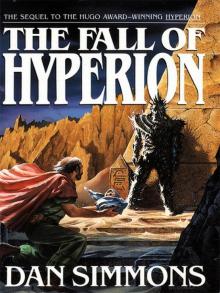 The Fall of Hyperion
The Fall of Hyperion Black Hills
Black Hills A Winter Haunting
A Winter Haunting Hard Freeze
Hard Freeze Prayers to Broken Stones
Prayers to Broken Stones Hard as Nails
Hard as Nails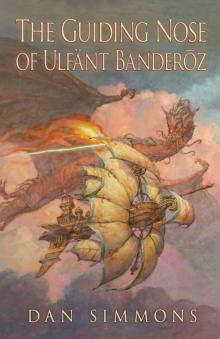 The Guiding Nose of Ulfant Banderoz
The Guiding Nose of Ulfant Banderoz The Rise of Endymion
The Rise of Endymion Orphans of the Helix
Orphans of the Helix Lovedeath
Lovedeath Olympos
Olympos Darwin's Blade
Darwin's Blade Song of Kali
Song of Kali Worlds Enough & Time: Five Tales of Speculative Fiction
Worlds Enough & Time: Five Tales of Speculative Fiction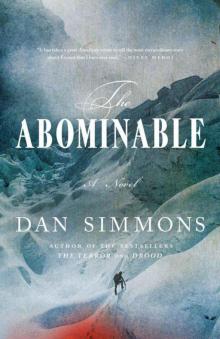 The Abominable
The Abominable The Death of the Centaur
The Death of the Centaur Hard as Nails jk-3
Hard as Nails jk-3 Worlds Enough & Time
Worlds Enough & Time Joe Kurtz Omnibus
Joe Kurtz Omnibus The Hyperion Cantos 4-Book Bundle
The Hyperion Cantos 4-Book Bundle Rise of Endymion
Rise of Endymion Hard Freeze jk-2
Hard Freeze jk-2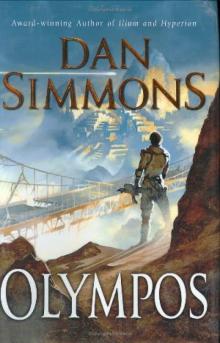 Olympos t-2
Olympos t-2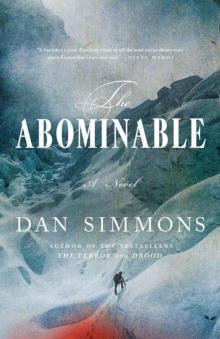 The Abominable: A Novel
The Abominable: A Novel Hyperion h-1
Hyperion h-1 Remembering Siri
Remembering Siri Black Hills: A Novel
Black Hills: A Novel Ilium t-1
Ilium t-1 Hardcase jk-1
Hardcase jk-1 Hyperion 01 - Hyperion
Hyperion 01 - Hyperion